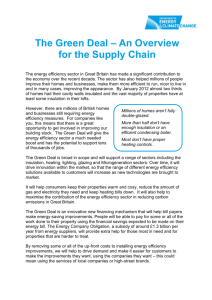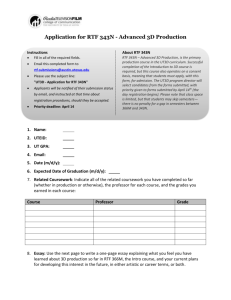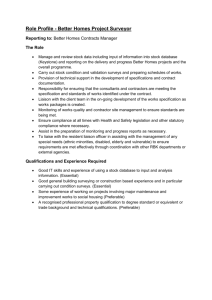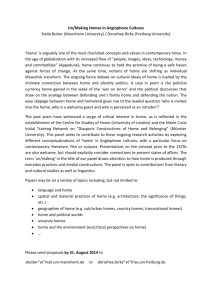Research Strategy
advertisement
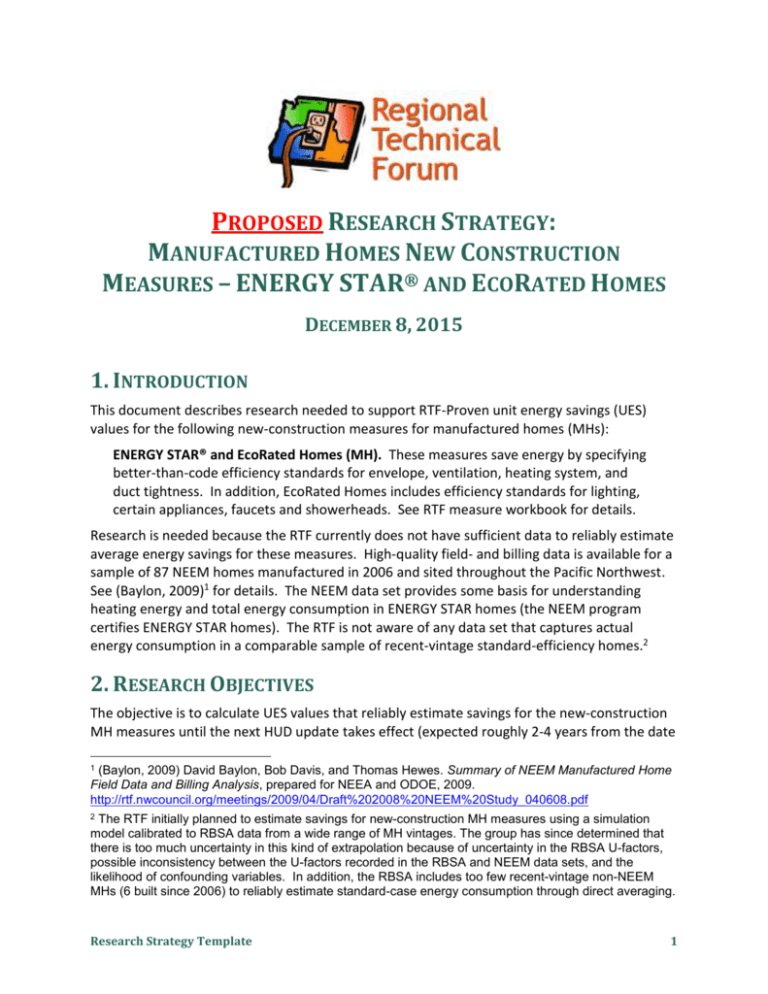
PROPOSED RESEARCH STRATEGY: MANUFACTURED HOMES NEW CONSTRUCTION MEASURES – ENERGY STAR® AND ECORATED HOMES DECEMBER 8, 2015 1. INTRODUCTION This document describes research needed to support RTF-Proven unit energy savings (UES) values for the following new-construction measures for manufactured homes (MHs): ENERGY STAR® and EcoRated Homes (MH). These measures save energy by specifying better-than-code efficiency standards for envelope, ventilation, heating system, and duct tightness. In addition, EcoRated Homes includes efficiency standards for lighting, certain appliances, faucets and showerheads. See RTF measure workbook for details. Research is needed because the RTF currently does not have sufficient data to reliably estimate average energy savings for these measures. High-quality field- and billing data is available for a sample of 87 NEEM homes manufactured in 2006 and sited throughout the Pacific Northwest. See (Baylon, 2009)1 for details. The NEEM data set provides some basis for understanding heating energy and total energy consumption in ENERGY STAR homes (the NEEM program certifies ENERGY STAR homes). The RTF is not aware of any data set that captures actual energy consumption in a comparable sample of recent-vintage standard-efficiency homes.2 2. RESEARCH OBJECTIVES The objective is to calculate UES values that reliably estimate savings for the new-construction MH measures until the next HUD update takes effect (expected roughly 2-4 years from the date 1 (Baylon, 2009) David Baylon, Bob Davis, and Thomas Hewes. Summary of NEEM Manufactured Home Field Data and Billing Analysis, prepared for NEEA and ODOE, 2009. http://rtf.nwcouncil.org/meetings/2009/04/Draft%202008%20NEEM%20Study_040608.pdf 2 The RTF initially planned to estimate savings for new-construction MH measures using a simulation model calibrated to RBSA data from a wide range of MH vintages. The group has since determined that there is too much uncertainty in this kind of extrapolation because of uncertainty in the RBSA U-factors, possible inconsistency between the U-factors recorded in the RBSA and NEEM data sets, and the likelihood of confounding variables. In addition, the RBSA includes too few recent-vintage non-NEEM MHs (6 built since 2006) to reliably estimate standard-case energy consumption through direct averaging. Research Strategy Template 1 of this writing). To be reliable, savings estimates should be closely tied to observed differences in energy consumption between samples of standard-efficiency and efficient-case homes. Engineering models may be used to account for differences between study samples and likely program applications, but the final savings estimates should be largely driven by the differences in consumption that are observed between study samples. To meet the objective, researchers need to identify (or collect) data for a sample of efficientcase homes and a comparable sample of standard-efficiency homes.3 Data should include actual consumption records and any home/site characteristics that may be needed to adjust or filter the samples so the observed differences in energy consumption will be clearly meaningful. Research does not necessarily need to include separate samples for each efficient-case measure specification or for each heating zone. For instance, the straw-man approach described in the next section initially fits a regression to predict actual heating energy (per billing data) as a function of a simulation model’s output. The approach then applies the fitted regression function to simulation models that vary to reflect expected program populations, other heating zones, and detailed construction specifications. Improving understanding of as-built shell components is not an objective of this research. NEEM construction standards are well known from (Baylon, 2009), the references therein, and ongoing certification activities. The RTF plans to use professional judgment and existing data to estimate specifications that reflect average standard-efficiency practices.4 Improving understanding of the mix of efficient-case and standard-efficiency homes that should be included in the baseline is also not an objective of this research. The RTF plans to use professional judgment to estimate the correct baseline mix.5 Researchers must determine whether consumption data from the existing NEEM sample (described in the previous section) should be included in this study (the key question is whether consumption in that sample can be meaningfully compared to consumption in an attainable standard-efficiency sample). The RTF expects that engineering models can provide sufficient rigor to account for differences between NEEM and EcoRated homes. 3 Here, standard efficiency refers to construction practices that are typical of manufactured homes that do not meet the NEEM or EcoRated requirements. These practices vary by manufacturer, so researchers should plan to collect data from multiple manufacturers in order to capture the full range of “standard” efficiency levels. The likely starting point for this estimate is the “HUD+” specification, which was developed by Northwest Energy Works and researchers at WSU for the RTF’s High-Performance Manufactured Homes (HPMH) measure. HUD+ specs and background are provided in the 2012 HPMH presentation to the RTF, available here: http://rtf.nwcouncil.org/meetings/2012/05/HPMH_Proposal_20120515_v2a.ppt. Specifications observed in the present study’s standard-efficiency sample may be useful for updating these specifications. 4 The RTF guidelines specify a Current-Practice baseline that reflects “typical choices of eligible endusers.” A current-practice baseline would include efficient-case and standard-efficiency homes in proportion to their current market shares. However, RTF judgment is needed because past experience with manufactured homes suggests that when program support is removed, efficient-case market share drops precipitously and standard-construction practices become less efficient. 5 Research Strategy Template 2 3. DATA COLLECTION AND ANALYSIS This section describes a “straw-man” research path that the RTF judges as having a high likelihood of leading to a proven UES for the two MH new-construction measures. The purpose of this description is to clarify the level of rigor and the size of the research lift needed to obtain proven-worthy savings estimate. The RTF recognizes that Research Sponsors may determine that alternative methods are better suited to meeting the research objectives and obtaining proven results.6 Step 1: Sample design and data collection. To estimate average annual heating energy savings to within 750 kWh7 with 90% confidence, the sample is designed so that the final usable analysis sample will include approximately 154 efficient homes and 154 standard-efficiency homes.8 For each site, the analysis will require billing data (at least 12 consecutive months), location (county or zip code and whether the site is in a park or a private lot), standard (NEEM, EcoRated, or Other), building characteristics (asbuilt component U-factors and square footage), heating system type, and off-grid heat (presence or absence at minimum). To confirm heating system type and the presence or absence of off-grid heat, researchers are likely to need customer contact (phone interview) or visual site inspections. Qualitatively, researchers should make reasonable efforts to avoid major discrepancies between standard-efficiency and efficient-case samples. For example, if efficient-case homes are predominantly sited on private lots while the standard-efficiency sample is focused in a small number of trailer parks, unknown demographic variables may make it difficult to draw meaningful comparisons between the two samples. With a reasonably broad sampling frame, random or quasi-random sampling can help reduce discrepancies between standard-efficiency and efficient-case samples. However, sampling does not need to be rigorously representative with respect to geographic distribution – for instance, it may be possible to obtain reliable results based on sites sampled from only one or two climate zones. 6 Sponsors should work with RTF staff to document funded research plans for presentation to the RTF. At that time, the measure category will be changed from Planning to Provisional if the RTF agrees that (1) the planned research is likely to yield results that move the measure toward the Proven UES reliability standard, and (2) the research can be used in evaluations to estimate savings for measure installations during the measure sunset period. 7 Table 28 of (Baylon, 2009) estimates sample-average heating energy for electric-resistance NEEM homes as 9134 kWh/yr. NEEM specs represent about a 20% reduction in Uo relative to HUD+, so a reasonable a priori savings estimate is 9134 × (1/0.8 – 1) ≈ 2300 kWh/yr. Based on these assumptions, a confidence band of ±750 kWh/year represents approximately 33% precision. 8 The connection between confidence band and sample size is based on heating energy standard deviations published in (Baylon, 2009): Focusing on values for electric resistance heat, Table 26 suggests the standard deviation of VBDD heating energy is approximately 4000 kWh for NEEM homes. Assuming the same standard deviation for standard homes, the 90% confidence band for savings becomes ±1.645 × √2 × 4000/√𝑛, where 𝑛 is the number of NEEM homes and the number of standard homes. Setting this equal to 750 yields 𝑛 = 154. Research Strategy Template 3 In addition, researchers should attempt to include standard-efficiency observations that span a wide range of non-NEEM construction standards. The sample does not need to be rigorously representative in this respect. Researchers may choose to simplify the analysis by limiting the sample to homes without natural gas or heat-pumps.9 Sample attrition may be caused by difficulties related to data collection and data filters used in the analysis. Step 2: Data Analysis (to be performed by RTF). Estimate normalized annual heating energy for each home in the sample through billing analysis. Separately, create a SEEM model for each house using site-specific inputs for climate, component U-factors, and square footage, and using standardized inputs for other variables (note: internal gain inputs may need to account for efficient lighting and appliances in EcoRated homes). Finally, plot y = VBDD heating kWh versus x = SEEM heating kWh and fit a regression to estimate (predict) VBDD heating energy as a function SEEM output. Step 3: Final UES adjustments (to be performed by RTF). For each measure application (heating zone, home configuration, etc.) create SEEM models with inputs that reflect baseline10 and efficient shell conditions. Plug SEEM output into the regression from Step 2 to obtain predicted VBDD heating energy for the standard and efficient cases. The final estimate of shell savings (for the given application) is the difference between predicted VBDD (baseline) and predicted VBDD (efficient). Other savings components, such as lighting, appliances, and DHW can be accounted for using external data sources and standard HVAC interaction factors. As noted above, the RTF recognizes that alternative research approaches may provide a viable path to proven savings. However, the RTF’s judgment is that the following approach is not likely to yield savings estimates that are sufficiently reliable for proven UES values for the newconstruction MH measures: Engineering estimates or simulation modelling that are not calibrated based on observed differences between energy consumption in recent-vintage efficient homes and energy consumption in recent-vintage baseline homes. 4. ESTIMATED COST RANGE (< $25k) ($25k-$100k) ($100k-$250k) ($250k-$500k) ($500k-$1MM) ($1MM-$2MM) (> $2MM) The RTF estimates the cost of research would be between $100,000 and $250,000. The main expenses are data collection, data management, and data analysis. This estimate does not include data analysis and final UES adjustments performed by the RTF (Steps 2 and 3, above). Cost estimates do not include program operations or contractor incentives. The RTF has a separate research strategy outlining the region’s needs for better understanding of heat pump commissioning, controls, and sizing (CC&S). If heat pumps are included in the present study, study results may be difficult to interpret because of uncertainty related to CC&S. 9 10 The baseline may include a mix of standard and efficient-case homes. This will depend on RTF judgment. Research Strategy Template 4



